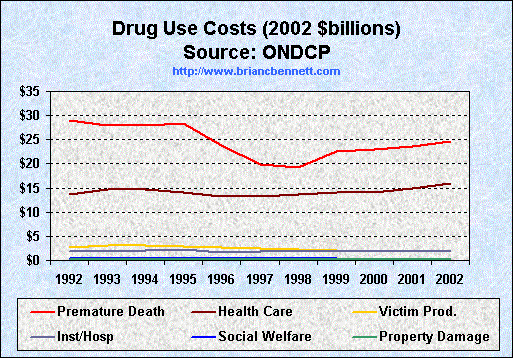Drug Use Cost Breakdown
(2005 Update)
| When allocating the overall costs to either a cost of drug use or a cost of drug war, the primary consideration was: is this a cost that would exist if the drugs were legal? If so, it was allocated as a cost of drug use, as explained below. Otherwise, it is allocated as a cost of drug war. |

| Categorizations and Values for Drug Use Costs (2002 $billions) | |||||||||||
|---|---|---|---|---|---|---|---|---|---|---|---|
| Category | 1992 | 1993 | 1994 | 1995 | 1996 | 1997 | 1998 | 1999 | 2000 | 2001 | 2002 |
| Premature Death | $28.961 | $27.877 | $28.034 | $28.406 | $23.745 | $19.901 | $19.323 | $22.535 | $23.045 | $23.686 | $24.646 |
| Health Care Costs | $13.659 | $14.662 | $14.673 | $13.996 | $13.158 | $13.236 | $13.756 | $14.044 | $14.128 | $14.861 | $15.845 |
| Productivity Loss of Victims of Crime |
$2.640 | $3.098 | $3.100 | $2.806 | $2.674 | $2.570 | $2.279 | $2.111 | $1.930 | $1.835 | $1.800 |
| Institutionalization/ Hospitalization |
$1.894 | $1.870 | $2.043 | $2.210 | $1.758 | $1.863 | $1.971 | $1.873 | $1.782 | $1.870 | $1.996 |
| Social Welfare | $0.337 | $0.418 | $0.432 | $0.442 | $0.446 | $0.434 | $0.417 | $0.317 | $0.275 | $0.253 | $0.235 |
| Property Damage | $0.247 | $0.285 | $0.280 | $0.256 | $0.245 | $0.233 | $0.205 | $0.206 | $0.206 | $0.206 | $0.206 |
| Grand Totals | $47.74 | $48.21 | $48.56 | $48.12 | $42.03 | $38.24 | $37.95 | $41.09 | $41.37 | $42.71 | $44.73 |
Source: The Economic Costs of Drug Abuse in the United States,
Office of National Drug Control Policy (Dec 2004)
|
Table Notes:
Health Care Costs are mostly from Community Based Specialty Treatment (approx 38% of total health care costs) and HIV/AIDS treatment (approx 24% of total health care costs) for a combined 62% of the total Health Care Costs. |